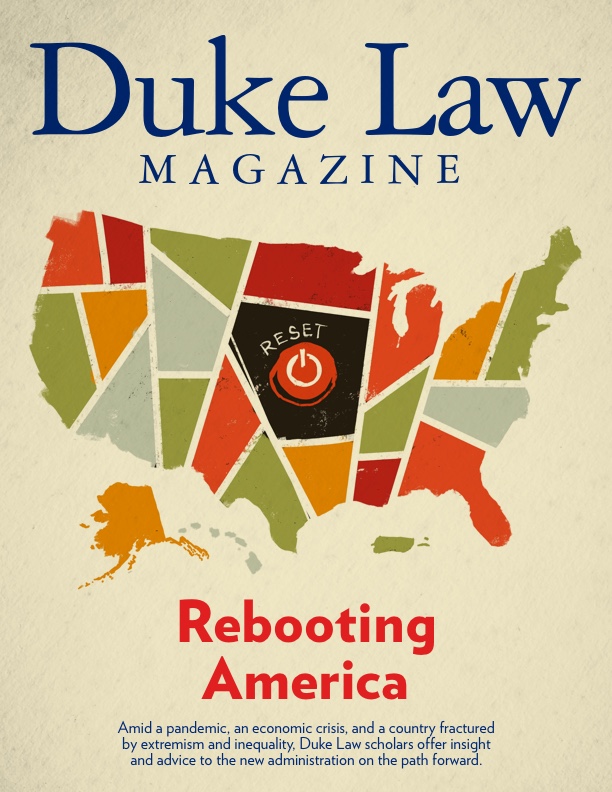
Financial regulation | Gina-Gail Fletcher
Use financial regulatory tools and institutions to address wealth gap, lending disparities

Prior to his inauguration, President Biden’s transition team identified several priorities that relate to financial regulation. At the top, of course, is combatting COVID-19 and containing the impact the pandemic has had on households and on the economy. Another priority is very different and, to me, quite fresh: addressing racial inequality.
It’s not surprising that the Biden administration is focusing on racial inequality. But it is interesting — even surprising — that they’re considering racial inequality from a financial regulatory perspective and not just from a social or welfare perspective. Hopefully, they will start thinking about it on multiple dimensions, including in terms of appointing diverse people to lead or to be a part of different agencies, such as the Federal Reserve, the Securities and Exchange Commission, and the Commodities Futures Trading Commission, which have generally not had very diverse leadership.
Minority-owned banks and community development banks are foundational to communities of color, so supporting these types of institutions is key to trying to address racial inequity within the financial markets.
I also hope the Biden administration will focus on the ways in which certain financial or regulatory practices have a disparate impact on women and minority communities. The administration should think through different ways to ensure that communities of color and businesses owned by women and people of color can thrive as a part of our economic recovery and are not further excluded from the mainstream financial industry.
I think a huge part of that will involve turning our focus towards minority owned banks and community development banks. These are foundational to communities of color, often serving underrepresented groups and operating in “banking deserts” — rural areas and communities that don’t get serviced by many financial institutions. They are, oftentimes, the only ones that lend to certain entrepreneurs of color. So focusing on or supporting these types of institutions, I think, is key to moving forward this agenda item of trying to address racial inequity within the financial markets.
The Biden administration should also rein in payday lending, which is focused a lot on lower-income communities that also are disproportionately communities of color. The Trump administration rolled back Obama administration payday reform efforts and it can be expected that the Biden administration will reinstitute them. I think payday lending reform will be huge for addressing racial inequality within the financial markets.
During the campaign, President Biden embraced a real-time payment system that could allow lower-income people to have better access to the banking system. This is something that could be useful as the administration addresses racial inequality within the markets, but requires congressional action.
The Biden administration might also look into revitalizing or expanding the Community Reinvestment Act (CRA), which is like a fair lending law for lending to low-income communities. Certain legislators have negative thoughts about what the CRA does and what it’s for, and have unfairly blamed it as a cause of the 2008 crisis. But various studies have shown that it was not; the CRA did not force banks to lend to people who didn’t have the requisite credit.
I think the administration might want to rethink how we use the CRA or something similar, if it is revamped, as a way to really get at the racial wealth inequality that plagues the country, because for so many minority minorities and underrepresented persons, their home is their largest asset. To be able to own a home and get into a home is a major point to growing their personal and generational wealth.
And the administration should think through ways to minimize or mitigate the bias that might arise, inherently, from within the structure of the bigger banks. This might involve implementing compliance rules that force banks to justify why borrowers who look the same on paper are getting different mortgage products or different financial products and, if race is playing a role, offer some way to adjust, so those applicants and consumers are not getting worse deals. It’s a deep problem that needs to be addressed, and to the extent that the administration has racial inequality as one of its top priorities, it’s something that I think should be at the top line of the agenda for the Federal Reserve and for, possibly, the Office of the Comptroller of the Currency.
Finally, I think that revitalizing the Consumer Financial Protection Bureau (CFPB) is an important step for the Biden administration to take in terms of supervising the markets and enforcing rules regarding payday lending and other types of loan facilities. The CFPB was supposed to be an agency that would lead on consumer protection, but under the Trump administration, it was decimated. In the first quarter of 2020 (according to the Brookings Institution), it collected just $8 in fines. But if restored to its place of prominence, the CFPB can help address racial inequality and wealth disparity. It doesn’t get us the whole way there, but it’s a huge stepping-stone to help us really address some instances of possibly discriminatory lending, discriminatory treatment of persons within the markets, and predatory behavior on the parts of various actors within the markets that targets low income people and definitely targets racial minorities.

